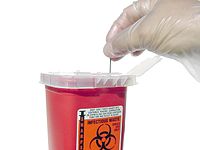

Abiological hazard, or biohazard, is a biological substance that poses a threat (or is a hazard) to the health of living organisms, primarily humans. This could include a sample of a microorganism, virusortoxin that can adversely affect human health. A biohazard could also be a substance harmful to other living beings.[a]
The term and its associated symbol are generally used as a warning, so that those potentially exposed to the substances will know to take precautions. The biohazard symbol was developed in 1966 by Charles Baldwin, an environmental-health engineer working for the Dow Chemical Company on their containment products.[1] It is used in the labeling of biological materials that carry a significant health risk, including viral samples and used hypodermic needles. In Unicode, the biohazard symbol is U+2623 (☣).
Biohazardous safety issues are identified with specified labels,[b] signs and paragraphs established by the American National Standards Institute (ANSI). Today, ANSI Z535 standards for biohazards are used worldwide and should always be used appropriately within ANSI Z535 Hazardous Communications (HazCom) signage, labeling and paragraphs. The goal is to help workers rapidly identify the severity of a biohazard from a distance and through colour and design standardization.[citation needed]
Biological hazard symbol design:
DANGER is used to identify a biohazard that will cause death. WARNING is used to identify a biohazard that may cause death. CAUTION is used to identify a biohazard that will cause injury, but not death. NOTICE is used to identify a non-injury biohazard message (e.g. hygiene, cleanup or general lab policies).
OSHA requires the use of proper ANSI HazCom where applicable in American workplaces. States and local governments also use these standards as codes and laws within their own jurisdictions. Proper use of ANSI Z535 signs, labels and paragraphs are written into many of OSHA's standards for HazCom and crafted to integrate with ISO symbols.
Reference ANSI Z535 for a complete description on how to use DANGER, WARNING, CAUTION and NOTICE signs, labels or paragraphs.
Biohazardous agents are classified for transportation by UN number:[2]


The United States Centers for Disease Control and Prevention (CDC) categorizes various diseases in levels of biohazard, Level 1 being minimum risk and Level 4 being extreme risk. Laboratories and other facilities are categorized as BSL (Biosafety Level) 1–4 or as P1 through P4 for short (Pathogen or Protection Level).[citation needed]
|
| |
|---|---|
| Modern incidents |
|
| Prevention and response |
|
| Biological agents |
|
| Related concepts |
|
| International law |
|
| |
|
| |||||
|---|---|---|---|---|---|
| Occupational diseases and injuries |
| ||||
| Occupational hygiene |
| ||||
| Professions |
| ||||
| Agencies and organizations |
| ||||
| Standards |
| ||||
| Safety |
| ||||
| Legislation |
| ||||
| See also |
| ||||
| |||||
|
| |||||||
|---|---|---|---|---|---|---|---|
| General |
| ||||||
| Preventive healthcare |
| ||||||
| Population health |
| ||||||
| Biological and epidemiological statistics |
| ||||||
| Infectious and epidemic disease prevention |
| ||||||
| Food hygiene and safety management |
| ||||||
| Health behavioral sciences |
| ||||||
| Organizations, education and history |
| ||||||
| |||||||
|
| |||||||||||||||||||||||||||||||||||||
|---|---|---|---|---|---|---|---|---|---|---|---|---|---|---|---|---|---|---|---|---|---|---|---|---|---|---|---|---|---|---|---|---|---|---|---|---|---|
| |||||||||||||||||||||||||||||||||||||
| |||||||||||||||||||||||||||||||||||||
| |||||||||||||||||||||||||||||||||||||
| |||||||||||||||||||||||||||||||||||||
| |||||||||||||||||||||||||||||||||||||
| |||||||||||||||||||||||||||||||||||||
| |||||||||||||||||||||||||||||||||||||
| |||||||||||||||||||||||||||||||||||||
| |||||||||||||||||||||||||||||||||||||
| |||||||||||||||||||||||||||||||||||||
| |||||||||||||||||||||||||||||||||||||
| |||||||||||||||||||||||||||||||||||||
| |||||||||||||||||||||||||||||||||||||
| |||||||||||||||||||||||||||||||||||||
| |||||||||||||||||||||||||||||||||||||
| |||||||||||||||||||||||||||||||||||||
| |||||||||||||||||||||||||||||||||||||
|
| |
|---|---|
| Air |
|
| Biological |
|
| Digital |
|
| Electromagnetic |
|
| Natural |
|
| Noise |
|
| Radiation |
|
| Soil |
|
| Solid waste |
|
| Space |
|
| Visual |
|
| War |
|
| Water |
|
| Topics |
|
| Misc |
|
| Responses |
|
| Lists |
|
| |
| Authority control databases: National |
|
|---|